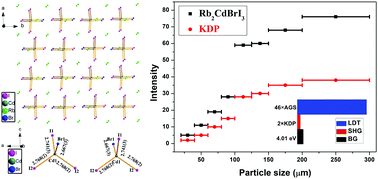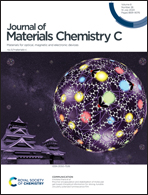Abnormal bandgap enlargement resulted in a promising mid-infrared nonlinear optical material Rb2CdBrI3 with an ultrahigh laser damage threshold†
Abstract
The low laser damage threshold of commercial infrared nonlinear optical materials is the main bottleneck that hinders their high-power coherent source applications. Here, a new compound Rb2CdBrI3 was successfully synthesized in a controlled manner by using a rational halogen substitution. It features a zero-dimensional [CdBrI3]2− tetrahedron and inserted Rb+ cations were used as the counter cations. In contrast to the isomorphic Rb2CdBr2I2, Rb2CdBrI3 exhibits an anomalously enlarged bandgap of 4.01 eV and an unprecedented high laser damage threshold up to 46 times that of AgGaS2. Theoretical calculations determine that the abnormal bandgap attributes to weak conduction band dispersion from the reduced net dipole moment and the enhanced halogen s–p orbital mixing when Br is replaced by I. This work not only promotes Rb2CdBrI3 as a promising infrared nonlinear converter, but also supplies new modulating viewpoints for the band-sensitive optoelectronic devices, such as hybrid perovskite solar cells with mixed halogen.



 Please wait while we load your content...
Please wait while we load your content...